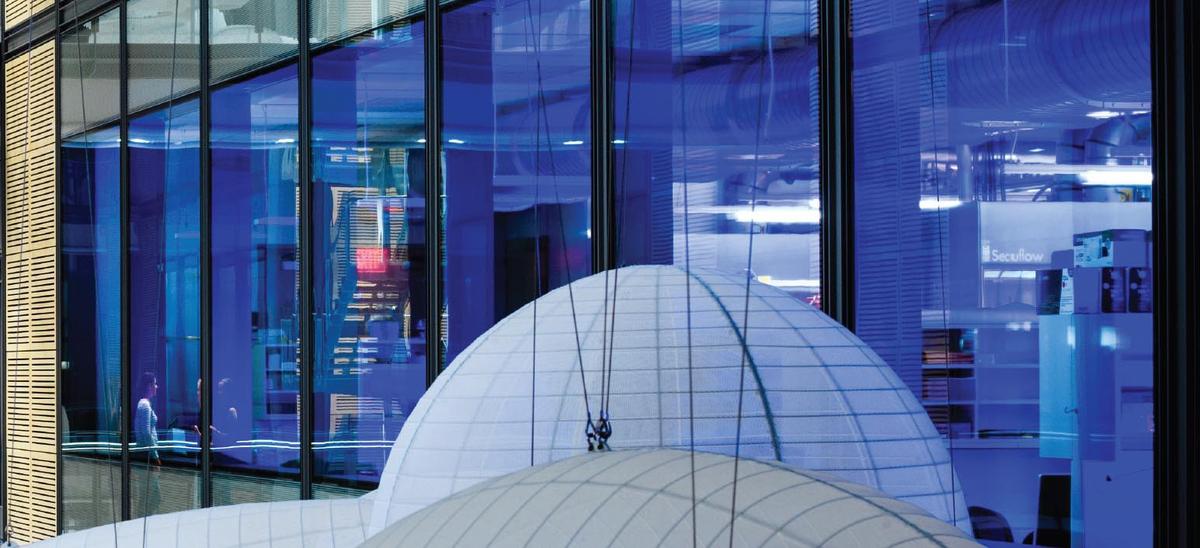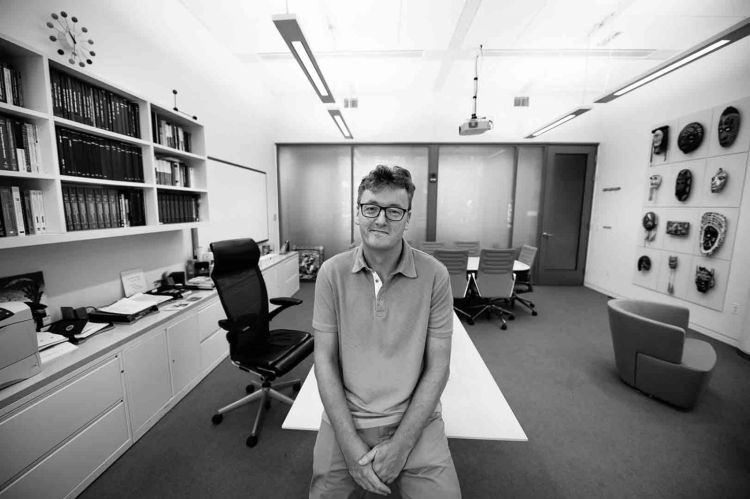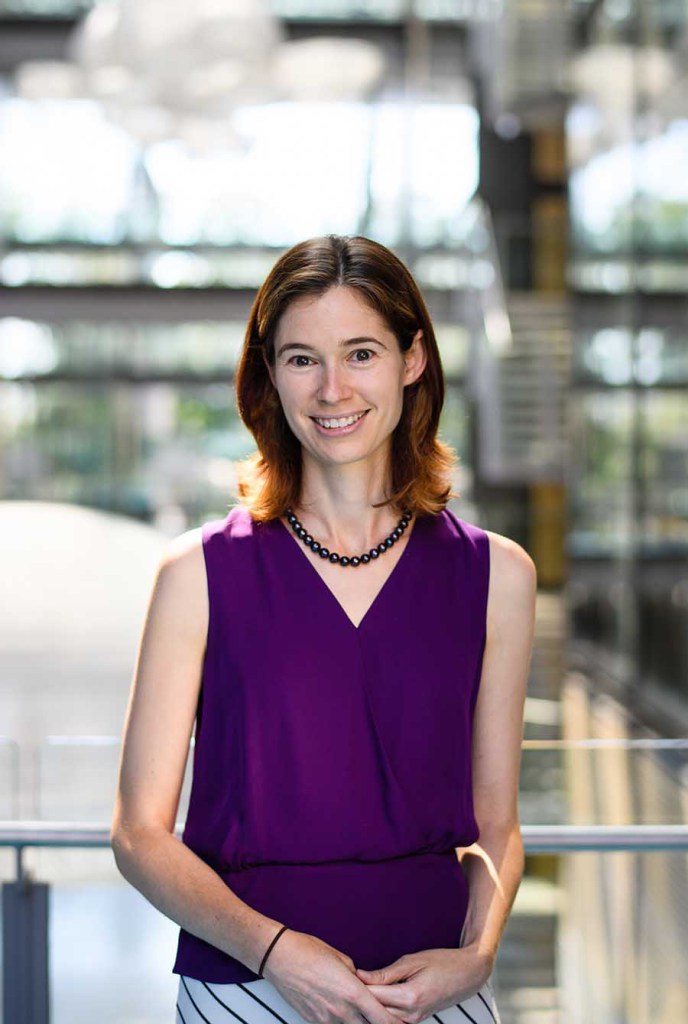Princeton researchers unlock the potential of light to perform previously impossible feats

One hundred years ago, Italian chemist Giacomo Ciamician predicted a future society that would run on sunlight.
In a paper presented in 1912 to an international meeting of chemists in New York City, he foresaw a future of vibrant desert communities under “a forest of glass tubes and greenhouses of all sizes” where light-driven chemical reactions would produce not just energy but also wondrous medicines and materials.
Ciamician’s vision has not yet arrived, but a handful of Princeton researchers have succeeded with one part of his legacy: they are harnessing light to perform previously impossible feats of chemistry. In Princeton’s Frick Chemistry Laboratory, blue LED lamps cast light on flask after flask of gently stirring chemicals that are reacting in ways they never have before to create tomorrow’s medicines, solvents, dyes and other industrial chemicals.
The leader in this emerging field is David MacMillan, who arrived in Princeton’s chemistry department in 2006. He was intrigued by the potential for using light to coax new chemical reactions. Like most chemists, he’d spent years learning the rules that govern the interactions of elements such as carbon, oxygen and hydrogen, and then using those rules to fashion new molecules. Could light help change these rules and catalyze reactions that have resisted previous attempts at manipulation?
Changing the rules
The idea for using light as a catalyst had been explored since Ciamician’s time with limited success. Light can excite a molecule to kick loose one or more of its electrons, creating free radicals that are extremely reactive and readily form new bonds with one another. However, most chemists did not think this process could be controlled precisely enough to make a wide variety of precision molecules.
But that changed in the summer of 2007.
MacMillan and postdoctoral researcher David Nicewicz were working on a tough problem. The two scientists wanted to create chemical bonds between one group of atoms, called bromocarbonyls, and another group, known as aldehydes. “It was one of those longstanding challenges in the field,” MacMillan said. “It was one of those reactions that was really useful for making new medicines, but nobody knew how to do it.”
Nicewicz had found a recipe that worked, but it involved using ultraviolet (UV) light. This high-energy form of light causes sunburn by damaging the molecules in the skin, and it also damaged the molecules in the reaction mixture, making the recipe Nicewicz had discovered less useful. MacMillan, who is Princeton’s James S. McDonnell Distinguished University Professor of Chemistry, asked Nicewicz to investigate how to do the transformation without UV light.
Nicewicz recalled some experiments that he’d seen as a graduate student at the University of North Carolina-Chapel Hill. Researchers led by chemistry professor Malcom Forbes had split water into oxygen and hydrogen fuel using visible light and a special molecule, a catalyst containing a metal called ruthenium. The approach was known as “photoredox catalysis” because particles of light, or photons, propel the exchange of electrons in a process called oxidation-reduction, or “redox” for short.

Photo by Sameer A. Khan/Fotobuddy
Visible light is lower in energy than ultraviolet light, so Nicewicz and MacMillan reasoned that the approach might work without damaging the molecules. Indeed, when the researchers added a ruthenium catalyst to the reaction mixture and placed the flask under an ordinary household fluorescent lightbulb, the two scientists were astounded to see the reaction work almost perfectly the first time. “More times than not, the reaction you draw on the board never works,” Nicewicz said. Instead, the reaction produced astonishing amounts of linked molecules with high purity. “I knew right away it was a fantastic result,” he said.
With support from the National Institutes of Health, MacMillan and Nicewicz spent the next year showing that the reaction was useful for many different types of bromocarbonyls and aldehydes, results that the team published in Science in October 2008. Research in the lab quickly expanded beyond this single reaction, and each new reaction hinted at a powerful shift in the rules of organic chemistry. “It just took off like gangbusters,” MacMillan said. “As time goes on you start to realize that there are nine or 10 different things that it can do that you didn’t think of.”
Old catalysts, new tricks
At the time that Nicewicz and MacMillan were making their discovery, chemistry professor Tehshik Yoon and his team at the University of Wisconsin-Madison found that combining the ruthenium catalyst with light produced a different chemical reaction. They published their work in 2008 in the Journal of the American Chemical Society the same day MacMillan’s paper appeared in Science. Within a year of MacMillan publishing his paper, Corey Stephenson, a University of Michigan chemistry professor, and his team found yet another photoredox-based reaction.
With these demonstrations of the versatility of photoredox catalysts, other chemists quickly joined the search for new reactions. About 20 photoredox catalysts were already available for purchase from chemical catalogs due to previous research on watersplitting and energy storage, so researchers could skip the months-long process of building catalysts. However, by designing and tailoring new catalysts, the chemists unlocked the potential to use light to drive numerous new reactions, and today there are more than 400 photoredox catalysts available.
The secret to these catalysts’ ability to drive specific reactions lies in their design. The catalysts consist of a central atom, often a metal atom such as ruthenium or iridium, surrounded by a halo of other atoms. Light frees an electron from the central atom, and the atoms surrounding the center act as a sort of channel that ushers the freed electrons toward the specific atoms that the chemists want to join.
One scientist who became intrigued with the power of photoredox catalysts was Abigail Doyle, a Princeton associate professor of chemistry. Doyle, whose work is funded by the National Institutes of Health, uses nickel to help join two molecules. In 2014, she was searching for a way to conduct a reaction that had long eluded other scientists. She wanted to find a catalyst that could make perhaps the most common bond in organic chemistry — between carbon and hydrogen — reactive enough to couple to another molecule. Perhaps a photocatalyst could make a reactive free radical, allowing her to then bring in a nickel catalyst to attach the carbon-carbon bond.

Photo by Sameer A. Khan/Fotobuddy
Unbeknownst to Doyle, the MacMillan lab had recently turned their attention to combining photoredox and nickel catalysts on a similar reaction, coupling molecules at the site of a carboxylate group, a common arrangement of atoms found in biological molecules from vinegar to proteins.
Given the similarities in their findings, the MacMillan and Doyle labs decided to combine their respective expertise in nickel and photoredox chemistry. Together, the teams found a photocatalyst based on the metal iridium that worked with nickel to carry out both coupling reactions — at the carbon-hydrogen bond and at the carboxylate group. Their collaborative paper, published in Science July 25, 2014, showed the extent of photoredox catalysis’ power to couple molecules with these common features.
The ability to combine molecules using natural features such as the carbon-hydrogen bond or the carboxylate group makes photoredox chemistry extremely useful. Often, chemists have to significantly modify a natural molecule to make it reactive enough to easily link to another molecule. One popular reaction — which earned a Nobel Prize in 2010 — requires several steps before two molecules can be linked. Skipping all these steps means a far easier and cheaper reaction — and one that is rapidly being applied.
“It’s one of the fastest-adopted chemistries I’ve seen,” Doyle said. “A couple of months after we published, we were visiting pharmaceutical companies and many of them were using this chemistry.”
The search for new drugs often involves testing vast libraries of molecules for ones that interact with a biological target, like trying thousands of keys to see which ones open a door. Pharmaceutical companies leapt at the chance to quickly and cheaply make many more kinds of molecules for their libraries.
Merck & Co., Inc., a pharmaceutical company with research labs in the Princeton area, was one of the first companies to become interested in using the new approach — and in funding MacMillan’s research.The company donated $5 million to start Princeton’s Merck Center for Catalysis in 2006, and recently announced another $5 million in continued research funding.
In addition to aiding drug discovery, photoredoxcatalyzed reactions can produce new or less expensive fine chemicals for flavorings, perfumes and pesticides, as well as plastic-like polymer materials. And the techniques keep getting cheaper. MacMillan published a paper June 23, 2016, in Science showing that with the aid of a photoredox catalyst, a widely used reaction to make carbon-nitrogen bonds can be carried out with nickel instead of palladium. Because nickel is thousands of times cheaper than palladium, companies hoping to use the reaction were contacting MacMillan before the paper was even published.
Spreading the light
Doyle has continued to explore photoredox chemistry, as have other Princeton faculty members, including two new assistant professors, Robert Knowles and Todd Hyster.
Hyster combines photoredox catalysis with reactions inspired by biology. Drugs often function by fitting in a protein like a hand fits in a glove. But just as placing a left hand in a right glove results in a poor fit, inserting a left-handed molecule into a protein designed for a right-handed molecule will give poor results. Many catalysts produce both the intended product and its mirror image, but by combining photoredox catalysts with artificial proteins, Hyster is finding reactions that can make that distinction.
Hyster, who arrived at Princeton in summer 2015, was drawn to Princeton’s chemistry department in part because of the opportunities to share knowledge and experience with other groups researching photoredox catalysis. “The department is quite collegial, so there’s no barrier when talking to colleagues about projects that are broadly similar,” he said.
Students from different labs chat about their work over lunch, teaching and learning informally — and formally, as the labs encourage collaboration and sharing expertise, said Emily Corcoran, a postdoctoral researcher who works with MacMillan. When Corcoran was trying to determine exactly how one of her reactions worked, she was able to consult with students in Knowles’ lab who had experience using sensitive magnetic measurements to find free radicals in the reaction mixture.
“If you have a question, you can just walk down the hall and ask,” Corcoran said. “That really pushes all the labs forward at a faster pace.”
A bright future
After the graduate students go home at night, the blue LEDs continue to drive new chemical reactions and new discoveries. “This is really just the beginning,” Doyle said.
Hyster thinks that within a few years, manufacturers may take advantage of photoredox chemistry to produce biological chemicals — such as insulin and the malaria drug artemisinin — to meet human needs. For his part, MacMillan envisions zero-waste chemical plants in the Nevada desert, driven not by fossil fuels but by the sun.
MacMillan’s vision echoes that of the original photochemist, Ciamician. The Italian’s optimistic vision of a sunlit future is brighter than ever.
This story first appeared in Discovery: Research at Princeton 2016-2017 produced by the Office of the Dean for Research and the Office of Communications.
